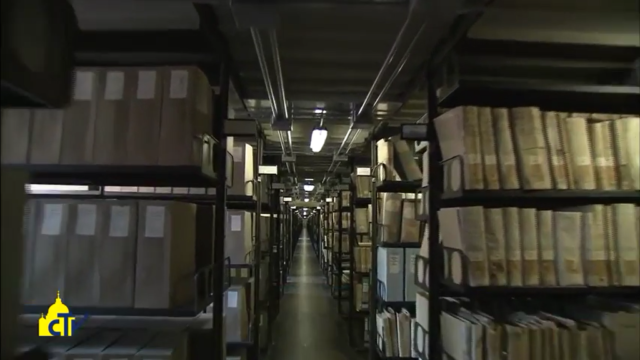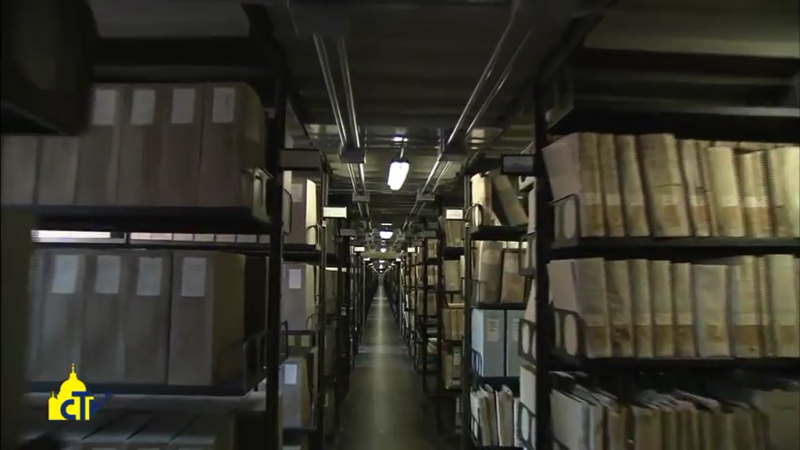The appearance of purple dots on manuscripts written in the Middle Ages has long been a frustrating problem. The dots grow and grow until they obscure the writing on a scroll or book page, making it impossible for us to read the words today. Keeping the manuscripts in a controlled environment, such as the air-conditioned, low-light sanctum of the Vatican Secret Archives, can only do so much. The spread of the purple dots has destroyed documents that historians are desperate to learn from.
But this year a team of researchers led by an eco-toxicologist at the University of Rome Tor Vergata–using as their sample a 16-foot-long, 1244 parchment roll asking that a man named Laurentius Loricatus be made a saint–discovered what created the purple dots. It was salt-loving marine microbes, according to a paper released September 7 in the journal Scientific Reports.
At first, the results just didn’t seem right. “When my students came to me, saying, ‘Luciana, we found marine bacteria,’ I told them, ‘Repeat, please; there is a mistake. There must be a mistake,’ ” Dr. Luciana Migliore told Live Science.
Purple spots marring Vatican scroll may have unlikely source https://t.co/z18LH2kSAO pic.twitter.com/znlO1GFMXI
— Newser (@Newser) 8 September 2017
The document that the team was testing has rested in the Vatican Secret Archives since the 18th century. It was written near Rome in the 13th century, when it was submitted to the Vatican. It was never anywhere near the sea that anyone knows of.
Thanks to more lab tests, the mystery was solved. Those tests proved that a centuries-old well-intended effort to preserve the parchments was sealing their eventual doom. Originally these writings were done on goat, sheep, or cow skins. After removing the hides from the animals, the practice was to immerse the skins in a prepared sea-salt bath. The goal was to preserve it, and the mixture would indeed kill off tiny insects. But over time, salt-tolerant marine bacteria grew and eventually produced purple pigment. As these bacteria died, they would be replaced by new organisms, creating a chain that ate away at the words once written with such care. Or in the words of the science journal: “We hypothesize a successional model of biodeterioration.”
Secret Vatican Manuscript’s Mysterious Purple Spots Decoded https://t.co/FhbTMEeOrG pic.twitter.com/TuVMAOBHBK
— ADEOGUN MUIDEEN A (@femba01) 7 September 2017
Whatever terms you want to use to define it, the color-purple damage has long baffled modern scientists. “Due to the widespread expansion of this kind of damage, often present on very important ancient documents, several studies have tried to understand its causes,” according to Scientific Reports.
The parchment the University of Rome team used for investigative purposes has an interesting history all its own. In the year 1205 or 1206, a teenage soldier later named Laurentius Loricatus accidentally killed a man in Rome. To try to earn God’s forgiveness, Laurentius withdrew from life, self-flagellating and wearing “instruments of penance.” He made a pilgrimage of penance to Santiago de Compostella in Spain and became a Benedictine monk. For 34 years he lived as a hermit in the ruins of a mountain monastery.
Mystery of the peculiar purple spots on 770-year-old Secret Vatican Archive scroll solved – International Business… https://t.co/UOAaOwMnH9 pic.twitter.com/G91853B3U7
— PrGareth (@PrGareth) 7 September 2017
Laurentius wrote a book of prayers that survived for many years. And he was extremely austere. If a visitor left him an offering, he gave it to the poor.
He was given the name Loricatus because he wore a coat of chain mail next to his skin as penance. This practice was not invented by him. Saint Loricatus, a Benedictine monk who died in 1060, devoted his adult life to penance, wearing an iron coat of mail next to his skin. In the case of Laurentius’s chain mail, according to Catholic Saints, “the future Pope Gregory IX finally persuaded him to give it up.”

After he died in 1243, those who admired Laurentius wrote on a parchment made of goat skin to the Pope, asking that he be designated a saint. This request took quite a long time to answer. In 1778, Pope Pius VI had Laurentius beatified, and he is now referred to as “Blessed Laurence Loricatus” and his memorial day is August 16.
The researchers who studied the Laurentius Loricatus scroll are hopeful that their understanding of the purple microbes can aid in preserving other documents of the Middle Ages and perhaps even in restoring them.
